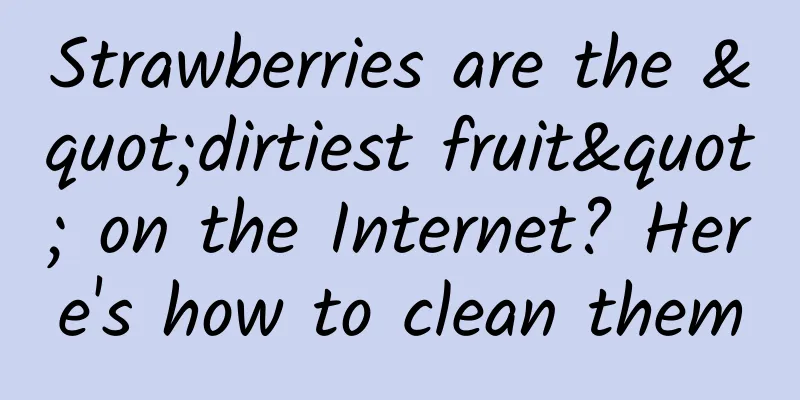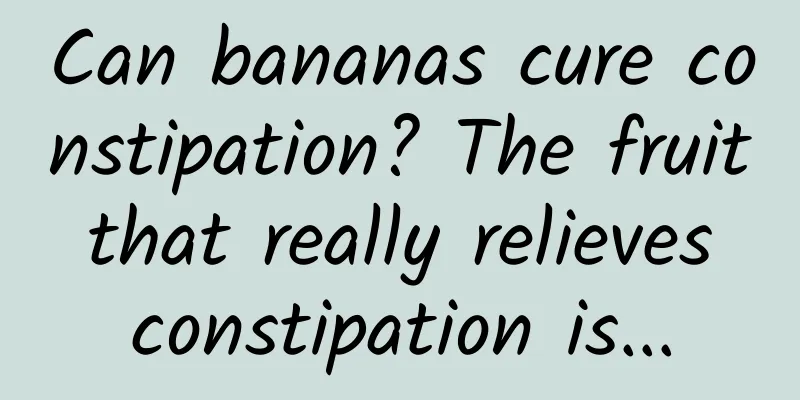Strawberries are the "dirtiest fruit" on the Internet? Here's how to clean them

|
For several years, strawberries have been rumored to be the dirtiest fruit. This rumor makes people feel sweet and worried every time they eat a strawberry. The rumor comes from an unreliable list of fruits and vegetables. From the perspective of pesticide residue detection, strawberries are not dirty! However, proper storage and cleaning can allow us to eat cleaner strawberries. As for how to wash them, you will know after reading today's article. Too long to read 1) Pesticides are indispensable in the process of strawberry cultivation, but using pesticides does not mean it is unclean; 2) The pass rate of pesticide residue detection in strawberries was as high as 98.9%, which was higher than the average of the overall random inspection of fruit categories; 3) Try to eat strawberries immediately after purchase, and throw away moldy or rotten strawberries; 4) For impatient friends, you can scroll to the end of the article to see the strawberry cleaning guide**** Our Top 1 Fruit is Not Dirty! The organization that proposed that "strawberries are the dirtiest" is the Environmental Working Group (EWG), a non-governmental environmental protection organization that publishes a list of the dirtiest fruits and vegetables every year, and strawberries have consistently topped the list in recent years. But in fact, this list is very problematic: the so-called "dirtiest" refers to the most detectable types of pesticides per strawberry, not the most serious pesticide residues. Many experts at home and abroad have also criticized this list: all the content that excludes dosage and talks about toxicity is meaningless except for creating panic. Image: Big Dodzy/unsplash According to regulations, strawberries must undergo frequent inspections by the national market supervision department before they are put on the market. The national food safety standards that the inspections are based on were jointly formulated by the Ministry of Agriculture and Rural Affairs, the National Health Commission, and the State Administration for Market Regulation, and have been continuously upgraded and improved over the past decade. According to national standards, trace amounts of pesticide residues are allowed on fruits and vegetables, and unless excessive amounts are ingested, the residual pesticides will not affect health. GB2763-2021 "National Food Safety Standard Maximum Residue Limits of Pesticides in Food" Release Announcement|Food Safety Standards and Monitoring and Evaluation Department What is the concept of "large intake"? Sang Liangliang, a horticultural crop technology extension staff member of the Shanghai Agricultural Technology Extension Service Center, once used dimethomorph as an example in an interview with The Paper. Dimethomorph is a commonly used fungicide in strawberry production, and its maximum residue limit is 0.05 mg per kilogram. An adult weighing 60 kg must eat 480 kilograms of strawberries in a day to exceed the daily intake limit of 12 mg of dimethomorph. Moreover, strawberries have always performed well in pesticide residue inspections. According to data from the State Administration for Market Regulation, from 2014 to date, the pass rate of strawberry pesticide residue inspections has reached 98.9%. In 2021, the Ministry of Agriculture and Rural Affairs announced that the overall pass rate of fruit pesticide residue sampling was 96.5% - compared with this set of data, strawberries are really misunderstood! The official query system of the State Administration for Market Regulation shows the sampling data of strawberries from 2014 to 2022|spcjsac.gsxt.gov.cn Is it necessary to use pesticides on strawberries? Although the strawberry pesticide residue test was fine, can we not use pesticides? Strawberries face various persecutions during their growth. Not only do humans covet their bodies, but bacteria, fungi, insects, and other small animals that can get close to them also love strawberries. Therefore, if we want to grow enough strawberries for us to eat and have excellent quality, we need professional production management methods and scientific pesticide application methods. In short, if you don't apply pesticides, you really won't get to eat strawberries! Strawberries grow quietly in a greenhouse|rperucho/Pixabay Before the start of each growing season, managers will clean and tidy up the production site, solve potential problems of pests and diseases, and provide all-round protection for the strawberry seedlings - irrigation equipment, insect protection, monitoring equipment, etc. But even if you have prepared a clean greenhouse and planted healthy strawberry seedlings, you still have to "vaccinate" the strawberries - that is, apply pesticides, which can prevent the strawberries from various diseases and pests. Moreover, strawberries are relatively fragile, and there are many types of diseases and pests that may appear, so you have to use a variety of different prescriptions, which also leads to a large number of pesticide residues in the strawberries. But only in this way can you provide a strong and effective protective barrier for strawberries and minimize the risk of diseases and pests in advance. After all, the most cost-effective way to produce strawberries is to vaccinate them and prevent them from getting sick or being infested with insects. If you wait until pests and diseases break out before intervening in management, you will not only have to invest more pesticides and money, but even the strawberries that have finally grown to half their size may be wiped out. Strawberry production environment map|Xinhua There are clear national standards for which pesticides can be used and which cannot be used. Highly toxic and extremely toxic pesticides are naturally prohibited; and for low-toxic chemical pesticides and biological pesticides, national standards also specify in detail the types and dosage requirements that can be used. In the actual production process, relevant departments will also regularly inspect the pesticide products purchased by enterprises based on the standards and supervise the frequency of application. In addition, after spraying, managers will reserve enough time before picking. This period of time without spraying is called the "safe interval" before fruits and vegetables are put on the market, and the pesticides will gradually metabolize during this period. The active ingredients of pesticides have metabolic characteristics, and according to information from the Agriculture and Rural Affairs Bureau, most pesticides have a half-life of only a few days, and pesticides with a long half-life will not be approved for use. In other words, most compliant pesticides do not take too long to be metabolized in large quantities, and will not accumulate in large quantities in plants or soil. Schematic diagram of pesticide half-life Pesticide half-life percentage change | Reference [2], picture translated by monica Therefore, if you buy strawberries from formal channels, they generally come from standardized producers and have passed qualified inspections before being put on the market, so there is no problem. Try not to hoard strawberries! When buying strawberries, we all know that we should choose those that look undamaged, hairy, or rotten. But if you accidentally choose the wrong ones, it's not a big deal. Pick out the problem strawberries first and see if the surrounding strawberries are affected - even if they are only slightly affected, pick them out together. The rest can be washed and eaten or stored in the refrigerator. Among problematic strawberries, those that are rotten or moldy must be thrown away as a whole - even if the rotten part is removed, the rest is inedible! The parts that appear to be not rotten may have already gone bad, but it is difficult to tell with the naked eye. Some strawberries are not rotten or moldy, but there is slight physical damage on the surface. This is not a big problem, just eat it quickly, but don't store these strawberries in the refrigerator, as they will breed many small cuties that you can't see (microbial contamination). Changes in mature strawberries infected with Botrytis cinerea | Reference [3], Chinese translation of the image: monica The length of time that strawberries can be stored in the refrigerator varies depending on the variety and the time of harvest, but generally 1 to 2 days is not a problem. However, we still recommend that you try to buy and eat them now so that you can enjoy the delicious food as soon as possible. A little tip: If you notice fog forming on the box or bag of strawberries, gently add a layer of paper towel inside before storing the strawberries in the refrigerator. The paper towel can absorb the fog, preventing moisture from exacerbating microbial contamination. Be sure to wash thoroughly before eating! It looks very clean, is it okay not to wash it? The answer is: it is best not to! Before strawberries reach your hands, they have to go through many processes such as picking, transit logistics, and shelf placement. Dust and microorganisms that are invisible to the naked eye are always around. Therefore, cleaning before eating is a necessary step, not to mention that cleaning can further remove pesticide residues! The most common method for washing strawberries is to use tap water. According to the test of the Polish National Institute, after 5 minutes of tap water soaking, about 70% of the pesticide residues were removed from the strawberries, which is clean enough and the effect is almost the same as washing with ozone water. They also tested ultrasonic cleaning and boiling cleaning - blanching strawberries can remove up to 93% of pesticide residues, but no one should want to eat ripe strawberries... Ultrasonic waves are also very effective, removing about 91% of residual pesticides. Data from the Polish National Laboratory: Taking the pesticide residue dosage of the fungicide Folpet under four cleaning treatment methods as an example (due to space limitations, not all data are shown): A tap water, B ozone water, C ultrasonic cleaning machine, D boiling water | Reference [1], Chinese translation of the picture: monica According to the experts from the Agricultural University, the Chinese Academy of Agricultural Sciences, and the Ministry of Agriculture and Rural Affairs, you can choose to soak the strawberries in salt water, white vinegar water, or baking soda water to remove the invisible bugs and microorganisms. The FDA also pointed out that low-concentration salt water (1-3%) can soak out the bugs in the fruit, and 1:8 vinegar water can effectively remove harmful microorganisms. Baking soda is alkaline and can neutralize commonly used acidic pesticide residues, thereby removing them. However, the epidermis structure of strawberries is relatively fragile, so the flavor is significantly affected by the "destruction" of cleaning agents such as acids, bases, and salts. You can choose according to the sensitivity of your tongue. Some people also use rice water and flour water to wash fruits and vegetables. In fact, experiments have shown that their effects in removing pesticide residues from strawberries are almost the same as tap water. On the contrary, rice water may still contain pesticide residues left over from washing rice. Therefore, it is not recommended to use these cleaning materials to wash strawberries. Image: ulleo/pixabay There is another type of detergent that the Academy of Agricultural Sciences, Agricultural University, FDA, and USDA recommend not to use on fruits and vegetables. If this type of product is not cleaned thoroughly, it will cause secondary residue. The strawberry skin is bumpy and easy to hide unwashed chemicals. In addition, the strawberry skin is fragile and tender, which is easily damaged during the washing process, and the cleaning chemicals may penetrate into the flesh. In summary, if the strawberries are found to be qualified for pesticide residue testing, they are clean enough even if they are only cleaned with water. Other additional methods can be mixed as appropriate. Do you feel that there are too many methods and you are already dazzled? Based on the above information, Calendar Girl has compiled a list of recommended cleaning steps. As for ultrasonic cleaning, although the data that it can remove 90%+ of pesticide residues is very tempting, after looking at the price of the machine, I decided to give it a try! Off topic: In addition to strawberries, there are also more and more berries such as blueberries, raspberries, and blackberries on the market. Are they also as controversial as strawberries? Nonono, these small berries come from shrubs that are not prone to insects and diseases. The types and amounts of pesticides required for their growth are much lower than those of strawberries, and there is no residue problem! But they have gone through many rounds of processing before they reach your hands, so the necessary cleaning cannot be omitted! Berries in the picture: strawberries, raspberries, blackberries, currants, blueberries | Couleur/pixabay References [1] Removal of 16 pesticide residues from strawberries by washing with tap and ozone water, ultrasonic cleaning and boiling Hanson, B.; Bond, C.; Buhl, K.; Stone, D. 2015. [2] Estimating Half-Lives for Pesticide Dissipation from Plants Peter Fantke, Brenda W. Gillespie, Ronnie Juraske, and Olivier Jolliet, 2014 [3] Gray mold of strawberry, a devastating disease caused by the ubiquitous necrotrophic fungal pathogen Botrytis cinerea, Stefan Petrasch, Steven J. Knapp, Jan AL van Kan, Barbara Blanco-Ulate, 2019 [4] Study on universal cleaning solution in removing blended pesticide residues in Chinese cabbage ZHANG Yu-shan1 *, LI Xiao-peng2 , LIU Hong-mei2 , ZHANG Yao-kun1 , ZHAO Fan-fei1 , YU Qinjie1 , LI Hao1 and CHEN Jian-wen2 [5] State Administration for Market Regulation [6] Ministry of Agriculture and Rural Affairs of China; local agriculture and rural bureaus Author: monica Editor: Mai Mai This article comes from the Species Calendar, welcome to forward If you need to reprint, please contact [email protected] |
>>: Revealed! Why are more and more young people having gray hair?
Recommend
How can community operations improve community activity?
In this article, the author divides community ope...
How to set up event prizes like Alipay Koi?
Prizes are inducement conditions that stimulate us...
Apply these 4 strategies for time-segmented delivery in SEM!
When it comes to bidding time periods, many compa...
Why is YouTube, the world's largest revenue earner, not making money?
Video websites have been very popular these days....
Not too big, not too small, why is the human body size just right?
In this world, although everyone's height and...
The glory of technology The Rise Talk wonderful views in-depth interpretation of cloud services
Recently, following the Prime Minister's visi...
Why are your left and right hands symmetrical? The Egyptian Sphinx gives the answer...
Why life prefers a certain chirality is a profoun...
Convolutional neural networks cannot process "graph" structured data? This article tells you the answer
This article introduces a paper about the applica...
Zhihu's "ambition and endgame"
The charm and value of market competition It took...
21 most commonly used growth techniques by foreign growth hackers
After testing and practicing throughout 2017, for...
It is said that the money counting machine has turned into a black hole: 40 banknotes were counted 9 times and only 10 were left
40 100-yuan bills were put into a money counting ...
Why do brands need to do influencer marketing?
First, influencer marketing platforms are no long...
1 person died, many people were rushed to the hospital! Be careful when traveling recently
Around 14:00 on April 5 Nanning, Guangxi Zhuang A...
Methodology for information flow delivery in wedding photography, food and other industries!
The information flow master who has been in the i...
What is considered a good self-media background? Which one is better, Toutiao or Penguin?
A few days ago, at a "copycat press conferen...









